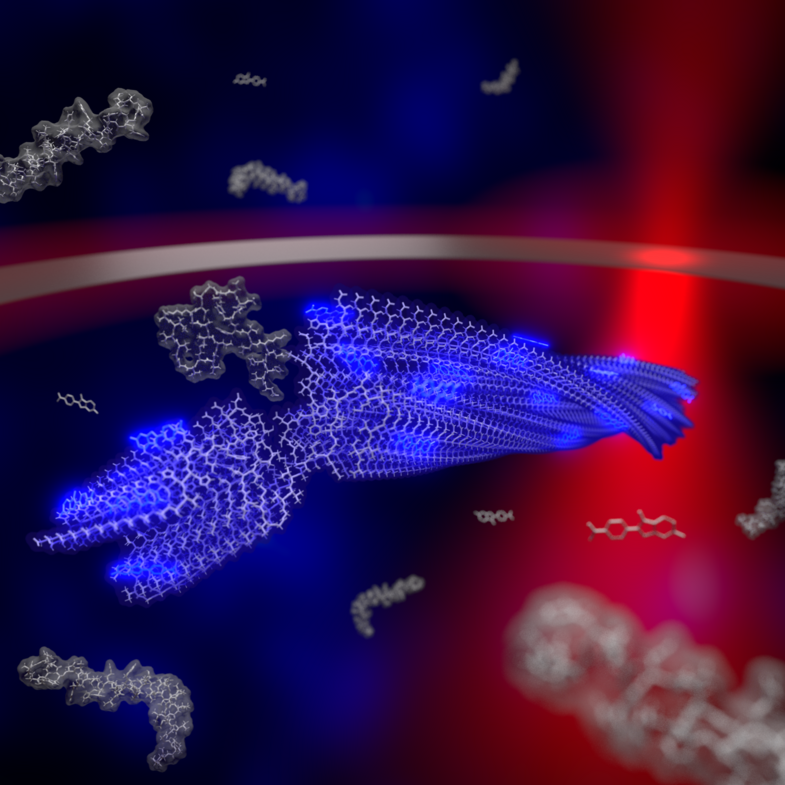Utilizing Active Microparticles for Artificial Intelligence
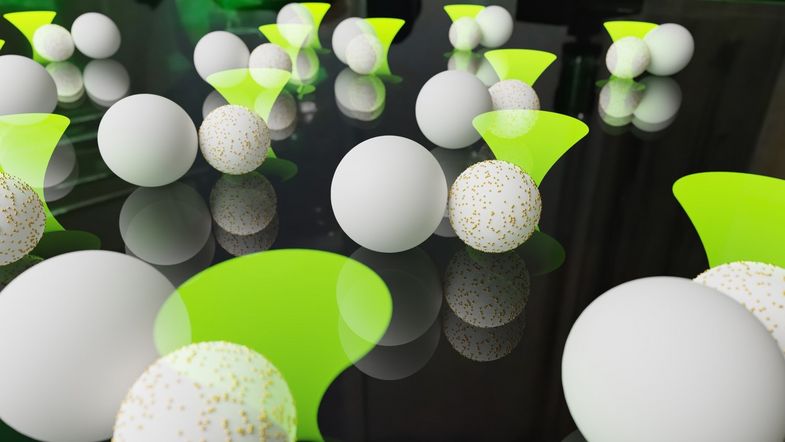 Artificial intelligence using neural networks performs calculations digitally with the help of microelectronic chips. Physicists at Leipzig University have now created a type of neural network that works not with electricity but with so-called active colloidal particles. In their publication in the prestigious journal “Nature Communications”, the researchers describe how these microparticles can be used as a physical system for artificial intelligence and the prediction of time series.
Artificial intelligence using neural networks performs calculations digitally with the help of microelectronic chips. Physicists at Leipzig University have now created a type of neural network that works not with electricity but with so-called active colloidal particles. In their publication in the prestigious journal “Nature Communications”, the researchers describe how these microparticles can be used as a physical system for artificial intelligence and the prediction of time series.
“Our neural network belongs to the field of physical reservoir computing, which uses the dynamics of physical processes, such as water surfaces, bacteria or octopus tentacle models, to make calculations,” says Professor Frank Cichos, whose research group developed the network with the support of ScaDS.AI. As one of five new AI centers in Germany, since 2019 the research center with sites in Leipzig and Dresden has been funded as part of the German government’s AI Strategy and supported by the Federal Ministry of Education and Research and the Free State of Saxony.
“In our realization, we use synthetic self-propelled particles that are only a few micrometres in size,” explains Cichos. “We show that these can be used for calculations and at the same time present a method that suppresses the influence of disruptive effects, such as noise, in the movement of the colloidal particles.” Colloidal particles are particles that are finely dispersed in their dispersion medium (solid, gas or liquid).
For their experiments, the physicists developed tiny units made of plastic and gold nanoparticles, in which one particle rotates around another, driven by a laser. These units have certain physical properties that make them interesting for reservoir computing. “Each of these units can process information, and many units make up the so-called reservoir. We change the rotational motion of the particles in the reservoir using an input signal. The resulting rotation contains the outcome of a calculation,” explains Dr Xiangzun Wang. “Like many neural networks, the system needs to be trained to perform a particular calculation.”
The researchers were particularly interested in noise. “Because our system contains extremely small particles in water, the reservoir is subject to strong noise, similar to the noise that all molecules in a brain are subject to,” says Professor Cichos. “This noise, Brownian motion, severely disrupts the functioning of the reservoir computer and usually requires a very large reservoir to remedy. In our work, we have found that using past states of the reservoir can improve computer performance, allowing smaller reservoirs to be used for certain computations under noisy conditions.”
Cichos adds that this has not only contributed to the field of information processing with active matter, but has also yielded a method that can optimize reservoir computation by reducing noise.
Reference:
X. Wang, F. Cichos
Harnessing Synthetic Active Particles for Physical Reservoir Computing
Nat. Commun. 15, 774 (2024)
Source: Press Release Leipzig University, Picture: Frank Cichos
Third Prize for Benjamin Fanselow for his Talk at the Annual BuildMoNa Conference
On March 20–21, 2023, the Annual Conference of the Leipzig School of Natural Sciences – Building with Molecules and Nano-objects (BuildMoNa) took place. In addition to lectures by guest speakers, the program also included contributions from doctoral candidates in the form of talks and posters. The three best talks of the doctoral candidates were awarded with prizes. Benjamin Fanselow obtained the third prize for his talk on “Multiple thermophoretic particle trapping”.
Congratulations!
Swarm Intelligence Caused by Physical Mechanisms
 Seemingly spontaneously coordinated swarm behavior exhibited by large groups of animals is a fascinating and striking collective phenomenon. Experiments conducted by researchers at Leipzig University on laser-controlled synthetic microswimmers now show that supposed swarm intelligence can sometimes also be the result of simple and generic physical mechanisms. A team of physicists led by Professor Frank Cichos and Professor Klaus Kroy found that swarms of synthetically produced Brownian microswimmers appear to spontaneously decide to orbit their target point instead of heading for it directly. They have just published their findings in the renowned journal Nature Communications.
Seemingly spontaneously coordinated swarm behavior exhibited by large groups of animals is a fascinating and striking collective phenomenon. Experiments conducted by researchers at Leipzig University on laser-controlled synthetic microswimmers now show that supposed swarm intelligence can sometimes also be the result of simple and generic physical mechanisms. A team of physicists led by Professor Frank Cichos and Professor Klaus Kroy found that swarms of synthetically produced Brownian microswimmers appear to spontaneously decide to orbit their target point instead of heading for it directly. They have just published their findings in the renowned journal Nature Communications.
“Scientific research on herd and flock behavior is usually based on field observations. In such cases, it is usually difficult to reliably record the internal states of the herd animals,” Kroy said. As a result, the interpretation of observations frequently relies on plausible assumptions as to which individual behavioral rules are necessary for the complex collective groups under observation. Researchers at Leipzig University therefore developed an experimental model system of microswimmers that elicits properties of natural swarm intelligence and provides complete control over the individuals’ internal states, strategies, and transformation of signal perception into a navigational reaction.
Thanks to a sophisticated laser heating system (see image), the colloidal swimmers, which are visible only under the microscope, can actively self-propel in a water container by a kind of “thermophoretic self-propulsion” while their travel is permanently disturbed in a random manner by Brownian motion. “Apart from Brownian random motion, which is ubiquitous in microphysics, the experimental set-up provides complete control over the physical parameters and navigation rules of the individual colloidal swimmers and allows long-term observations of swarms of variable sizes,” Cichos said.
According to Cichos, when just a very simple and generic navigation rule is followed identically by all of the swimmers, a surprisingly complex swarm behavior results. For example, if the swimmers are aiming at the same fixed point, instead of them gathering at the same place a kind of carousel can form. Similar to satellites or atomic electrons, the swimmers then orbit their attractive center on circular paths of varying heights. The only “intelligent” behavioral rule required for this is that the self-propulsion responds to environmental perception with a certain time delay, which usually occurs in natural swarm phenomena from mosquito dances to road traffic anyway. It turns out that such a “delayed” effect alone is sufficient to form complex dynamic patterns such as the carousel described above. “Physically speaking, each individual swimmer can spontaneously break the radial symmetry of the system and go into circular motion if the product of the delayed time and swimming speed is large enough,” Kroy said. In contrast, the orbits of larger swarms and their synchronization and stabilization depend on additional details such as the steric, phoretic and hydrodynamic interactions between the individual swimmers.
Since all signal-response interactions in the living world occur in a time-delayed manner, these findings should also further the understanding of dynamic pattern formation in natural swarm ensembles. The researchers deliberately chose primitive and uniform navigation rules for their experiment. This allowed them to develop a stringent mathematical description of the observed phenomena. In the analysis of the delayed stochastic differential equations used for this purpose, the delay-induced effective synchronization of the swimmers with their own past turned out to be the key mechanism for the spontaneous circular motion. To a large extent, the theory allows us to mathematically predict the experimental observations. “All in all, we have succeeded in creating a laboratory for swarms of Brownian microswimmers. This can serve as a building block for future systematic studies of increasingly complex and possibly still unknown swarm behavior, and it may also explain why puppies often circle their food bowl when they are being fed,” Cichos said.
Reference:
X. Wang, P.-C. Chen, K. Kroy, V. Holubec, F. Cichos
Spontaneous Vortex Formation by Microswimmers with Retarded Attractions
Nat. Commun. 14, 56 (2023)
Source: Press Release Leipzig University, Picture: Xiangzun Wang
Doctoral Thesis Prize for Dr. Tobias Thalheim
On November 29, 2022, the Research Academy Leipzig awarded their annual doctoral thesis prizes to doctoral researchers from the three Graduate Centers. With this award, outstanding dissertations are honored that were written within the framework of the structured doctoral programs in the Graduate Centers.
Within the Graduate Center Mathematics, Computer Science and Natural Sciences, Dr. Tobias Thalheim received a doctoral thesis prize for his dissertation “Thermophoretic Trapping Experiments on Single Bio-Molecules”.
Congratulations!
Third BuildMoNa Award for Nicola Söker
On March 14, 2022 the awards ceremony of the Leipzig School of Natural Sciences – Building with Molecules and Nano-objects (BuildMoNa) took place. With the BuildMoNa Awards 2022, outstanding scientific results of the BuildMoNa doctoral candidates in the year 2021 are honored. Nicola Söker received the third prize for the paper
N.A. Söker, S. Auschra, V. Holubec, K. Kroy, F. Cichos
How Activity Landscapes Polarize Microswimmers Without Alignment Forces
Phys. Rev. Lett. 126, 228001 (2021)
Congratulations!
Scientists Develop new Thermofluidic Process for Lab-on-a-chip Applications
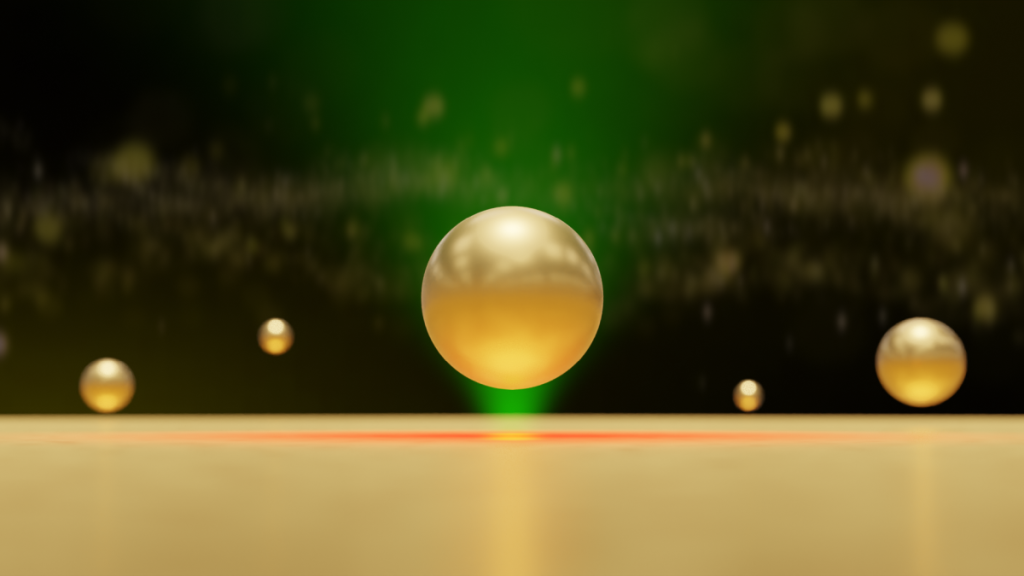 Researchers at Leipzig University have succeeded in moving tiny amounts of liquid at will by remotely heating water over a metal film with a laser. The currents generated in this way can be used to manipulate and even capture tiny objects. This will unlock groundbreaking new solutions for nanotechnology, the manipulation of liquids in systems in tiny spaces, or in the field of diagnostics, by making it possible to detect the smallest concentrations of substances with new types of sensor systems. In an article recently published in the high-impact journal “Nature Communications”, Martin Fränzl and Professor Frank Cichos of the Faculty of Physics and Earth Sciences at Leipzig University describe how this was achieved.
Researchers at Leipzig University have succeeded in moving tiny amounts of liquid at will by remotely heating water over a metal film with a laser. The currents generated in this way can be used to manipulate and even capture tiny objects. This will unlock groundbreaking new solutions for nanotechnology, the manipulation of liquids in systems in tiny spaces, or in the field of diagnostics, by making it possible to detect the smallest concentrations of substances with new types of sensor systems. In an article recently published in the high-impact journal “Nature Communications”, Martin Fränzl and Professor Frank Cichos of the Faculty of Physics and Earth Sciences at Leipzig University describe how this was achieved.
Martin Fränzl and Professor Frank Cichos have now found that they can generate very strong fluid flows even in the tiniest of channels by heating a very thin metal film on one side of the channel with a focused laser beam. The flows originate in an ultra-thin liquid layer just a few nanometres above the surface of the metal and mix the liquid in the channel with a specific flow pattern. Fränzl measured this flow pattern using nanoparticles as tracers. Not only have the scientists succeeded in exploring the origin of these currents, but they have also shown that they can capture, separate or transport nano-objects by cleverly combining currents and controlling other forces remotely by laser.
“This is fascinating,” said Fränzl, “because it allows us to control how objects and fluids move at the nanoscale without moving the entire fluid in the channels.” Similar approaches are already being used in a project run by the joint Transregio/Collaborative Research Centre 102 at the Martin Luther University Halle-Wittenberg and Leipzig University to study the formation of protein aggregates involved in the development of neurodegenerative diseases.
Both researchers are particularly interested in combining these laser-driven thermofluidics with machine learning techniques in order to create automated smart nanofactories – for nanoscale manufacturing, programmed material manipulation and sensor technologies – that optimise and adapt to new requirements based on the information they collect.
“We believe that thermofluidics will help us develop new technologies and solutions that may be highly useful for new collaborative projects such as the µChem initiative, which combines physics, chemistry, biochemistry and artificial intelligence in microenvironments,” said Professor Detlev Belder from the Institute of Analytical Chemistry at Leipzig University’s Faculty of Chemistry and Mineralogy. This paves the way for lab-on-a-chip applications.
The method was developed in collaboration with b-ACTmatter, the Interfaculty Centre for Bioactive Matter, which is being funded under the federal programme STARK. STARK was set up to promote the transformation process in coal regions. b-ACTmatter aims to develop new materials and technologies that contribute to an innovative, sustainable and circular development of the economy.
Reference:
M. Fränzl, F. Cichos
Hydrodynamic Manipulation of Nano-Objects by Optically Induced Thermo-Osmotic Flows
Nat. Commun. 13, 656 (2022)
Source: Press Release Leipzig University, Picture: Martin Fränzl
First Poster Prize for Martin Fränzl
 From October 17 to October 22, 2021, some group members participated in the Summer School on Photothermal Effects in Plasmonics – PEP2021 in Porquerolles, France. Within this summer school, Martin Fränzl received the first prize for his poster presentation on “Van der Waals assisted thermo-osmotic manipulation near surfaces”.
From October 17 to October 22, 2021, some group members participated in the Summer School on Photothermal Effects in Plasmonics – PEP2021 in Porquerolles, France. Within this summer school, Martin Fränzl received the first prize for his poster presentation on “Van der Waals assisted thermo-osmotic manipulation near surfaces”.
Congratulations!
How Tiny Machines Become Capable of Learning
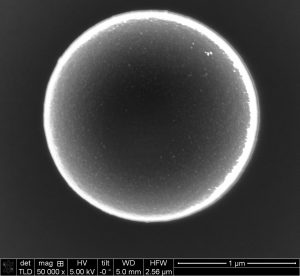 Living organisms, from bacteria to animals and humans, can perceive their environment and process, store and retrieve this information. They learn how to react to later situations using appropriate actions. A team of physicists at Leipzig University led by Professor Frank Cichos, in collaboration with colleagues at Charles University Prague, have developed a method for giving tiny artificial microswimmers a certain ability to learn using machine learning algorithms. They recently published a paper on this topic in the renowned journal “Science Robotics”.
Living organisms, from bacteria to animals and humans, can perceive their environment and process, store and retrieve this information. They learn how to react to later situations using appropriate actions. A team of physicists at Leipzig University led by Professor Frank Cichos, in collaboration with colleagues at Charles University Prague, have developed a method for giving tiny artificial microswimmers a certain ability to learn using machine learning algorithms. They recently published a paper on this topic in the renowned journal “Science Robotics”.
Microswimmers are artificial, self-propelled, microscopic particles. They are capable of directional motion in a solution. The Molecular Nanophotonics Group at Leipzig University has developed special particles that are smaller than one-thirtieth of the diameter of a hair. They can change their direction of motion by heating tiny gold particles on their surface and converting this energy into motion. “However, these miniaturised machines cannot take in and learn information like their living counterparts. To achieve this, we control the microswimmers externally so that they learn to navigate in a virtual environment through what is known as reinforcement learning,” said Cichos.
With the help of virtual rewards, the microswimmers find their way through the liquid while repeatedly being thrown off of their path, mainly by Brownian motion. “Our results show that the best swimmer is not the one that is fastest, but rather that there is an optimal speed,” said Viktor Holubec, who worked on the project as a fellow of the Alexander von Humboldt Foundation and has now returned to the university in Prague. According to the scientists, linking artificial intelligence and active systems like in these microswimmers is a first small step towards new intelligent microscopic materials that can autonomously perform tasks while also adapting to their new environment.
At the same time, they hope that the combination of artificial microswimmers and machine learning methods will provide new insights into the emergence of collective behavior in biological systems. “Our goal is to develop artificial, smart building blocks that can perceive their environmental influences and actively react to them,” said the physicist. Once this method is fully developed and has been applied to other material systems, including biological ones, it could be used, for example, in the development of smart drugs or microscopic robot swarms.
Reference:
S. Muiños-Landin, A. Fischer, V. Holubec, F. Cichos
Reinforcement Learning with Artificial Microswimmers
Sci. Robot. 6, eabd9285 (2021)
Source: Press Release Leipzig University
Thermoplasmonics: How can Heat be Used Effectively?
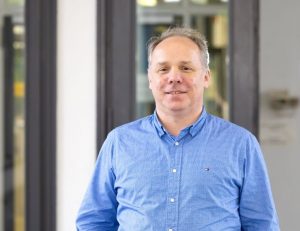
In many areas of technology, heat is perceived as an undesirable “by-product”. However, controlling the generation of heat, especially by small metal nanostructures, can create a variety of useful applications, which Professor Frank Cichos from the Peter Debye Institute for Soft Matter Physics at Leipzig University, together with colleagues from Marseilles and ETH Zurich, has now summarised in the journal “Nature Materials”.
The field of thermoplasmonics allows the generation of heat on the smallest length scales by the excitation of so-called plasmons – that is, collective electron excitations – in tiny metal structures, for example made of gold. These optically controlled sources of heat are unlocking new areas of application in medicine to treat cancer, to investigate processes in the development of neurodegenerative diseases, in chemistry to increase reaction yield, in photovoltaics, or even in 3D printing. The authors Cichos, Guillaume Baffou and Romain Quidant thus expect a variety of novel research approaches in the field of thermoplasmonics in the future.
Reference:
G. Baffou, F. Cichos, R. Quidant
Applications and Challenges of Thermoplasmonics
Nat. Mater. 19, 946–958 (2020)
Source: Press Release Leipzig University, Picture: Swen Reichhold
First BuildMoNa Award for Martin Fränzl
On June 18, 2020 the awards ceremony of the Leipzig School of Natural Sciences – Building with Molecules and Nano-objects (BuildMoNa) took place. With the BuildMoNa Awards 2020, outstanding scientific results of the BuildMoNa doctoral candidates in the year 2019 are honored. Martin Fränzl received the first prize for the paper
M. Fränzl, T. Thalheim, J. Adler, D. Huster, J. Posseckardt, M. Mertig, F. Cichos
Thermophoretic Trap for Single Amyloid Fibril and Protein Aggregation Studies
Nature Methods 16, 611–614, (2019)
Congratulations!
Machine Learning for Active Matter

Machine learning processes have experienced a huge increase in applications in many areas in recent years due to the availability of enormous amounts of data: from classifying objects and analyzing time series to controlling computer games and vehicles. In a current review in the journal “Nature Machine Intelligence”, authors from the universities in Leipzig and Gothenburg shed light on the current state of application and application possibilities of machine learning in the field of research on active materials.
Systems that are driven by the conversion of energy are referred to as active materials. The best example of active materials are biological systems from the individual molecular motor to bacteria and cells to entire organisms and swarms of animals. Active materials also include artificial systems made of nano- and microparticles that “imitate” the function of biological systems.
To build artificial intelligent systems for future technologies, one first has to understand natural intelligent systems, some of which have gone through millions of years of evolution. “There are amazing examples in nature,” says Prof. Dr. Frank Cichos from the Peter Debye Institute for Soft Matter Physics at Leipzig University. Birds like the albatross have learned to use atmospheric currents to glide. Plankton navigates in turbulent ocean currents and sperm control their motion based on noisy chemical signals that determine the microscopic world of active matter. In many cases, animals show collective behavior, they form swarms and use communication channels that allow them to change direction blazingly fast. To recognize and understand such complex processes, scientists worldwide are increasingly using machine learning methods, which are among the tools in the field of artificial intelligence.
What different approaches are currently available here and for which fields of application are they suitable? Frank Cichos with colleagues Kristian Gustavsson, Bernhard Mehlig and Giovanni Volpe from the University of Gothenburg in Sweden. The authors also show which pitfalls to watch out for. Prof. Dr. Frank Cichos has together with his colleagues Kristian Gustavsson, Bernhard Mehlig and Giovanni Volpe from the University of Gothenburg in Sweden assembled what different approaches are currently available here and for which fields of application are they suitable. The authors also show which pitfalls have to be taken into account.
Obvious applications of machine learning can be found in image analysis, i.e., in the detection of objects, for example, in microscopic images, their tracking over time and the characterization of their motion. Often, neural networks are trained with training data, which are also generated artificially or can be obtained from numerous experiments. “However, the variety of different processes that are already used in research on active materials is much greater,” says Cichos. Reinforcement learning – learning through rewards – is used to explore navigation strategies in complex currents, and deep learning methods help in the search for simpler physical models for pattern formation in complex currents. While these applications are all implemented on computers, there are also attempts to use artificial active matter as neural networks.
In addition to the fundamental knowledge that can be gained about active matter with the help of machine learning, technological applications also open up. The efficient gliding in air currents by means of sensory information, as examined for birds, can serve to optimize aircraft. Understanding collective behavior in swarms could be of interest for autonomous driving and navigation strategies can help in the active transport of medication in the human body.
Prof. Dr. Frank Cichos and his workgroup Molecular Nanophotonics at Leipzig University deal with artificial active matter in the micro- and nano-range. They create artificial particles that are driven by light and study their behavior. “Among other things, we want to investigate microscopic particles that show adaptive collective behavior and learn on the smallest length scales,” explains Cichos. For this purpose, the workgroup uses procedures of reinforcement learning so that active microparticles learn to explore their environment. They are also assisted by neural networks for the detection of their active particles in optical microscopy, which is superior to algorithmic methods, especially for many different particles.
From the authors’ perspective, the research of active matter can also help to improve the methodology of machine learning. “Research on active matter can easily generate large, high quality data sets across many length and time scales through experiments and physical models. Based on this data, new models for machine learning can be developed,” says Frank Cichos. But not all questions of active matter have to be solved with machine learning, Cichos points out. “With all the hype about machine learning, you also have to realistically assess whether you really need such a method if you can also tackle the problem with classic methods.“
Reference:
F. Cichos, K. Gustavsson, B. Mehlig, G. Volpe
Machine Learning for Active Matter
Nat. Mach. Intell. 2, 94–103 (2020)
Source: Translated for the Press Release of Leipzig University
In the Thermal Molecule Trap: New Experimental Approaches to Investigate the Molecular Causes of Amyloid Formation
More than 24 million people worldwide suffer from neurodegenerative diseases such as Alzheimer’s, Parkinson’s or Huntington’s. The molecular causes of these diseases have so far been little investigated. A team of scientists from Leipzig University and the Technical University of Dresden as well as the Kurt Schwabe Institute Meinsberg is now looking into these molecular mechanisms with new approaches and has used a self-developed technique: a thermal molecule trap. The researchers have just published their findings in the renowned journal “Nature Methods”.
Researchers assume that the cause of these neurodegenerative diseases is the aggregation of small protein molecules called peptides. Peptides usually perform different tasks in the body with their special three-dimensional structure. They act, for example, as hormones, are involved in the transport of substances through the cell membrane or act antibiotic or antiviral. However, when peptides come together to form small aggregates or even larger insoluble structures called plaques or amyloids, their original function is lost and peptide aggregates can even be toxic.
The way in which individual peptides become smaller aggregates and finally fibrils is not clear and experimentally difficult to observe. Even the growth of fibrils has not been sufficiently resolved since almost all previous studies have only been carried out for large quantities of molecules consisting of a mixture of peptides, aggregates and fibrils of different sizes.
The team of researchers from Leipzig, Dresden and Meinsberg has come up with new explanatory approaches: “When examining mixtures of single molecules, aggregates and fibrils for their properties, one obtains a picture of many overlapping effects. An important step towards a detailed understanding at the molecular level is to study the growth of individual amyloid fibrils,” explains Prof. Dr. Frank Cichos, head of the project within the Collaborative Research Center (CRC TRR 102) “Polymers under multiple constraints” at Leipzig University.
Using their newly developed technique, a thermal trap, researchers are now able for the first time to trap individual fibrils in physiological solutions for several hours under the microscope and to observe the growth of the fibril, its breakup and the further growth of the fragments. “Developing a technique for this purpose was a tricky task. Molecules in liquids move steadily due to the temperature of the liquid. This so-called Brownian motion quickly drives them out of our field of observation, and we can only observe individual fibrils for a very short time,” says Martin Fränzl, a doctoral candidate in the project.
The researchers are now harnessing the cause of Brownian motion, the thermal energy, to trap the fibrils in a small volume. “We use a laser to heat up a tiny metal ring, inside which the aggregates are trapped. The resulting temperature differences in the solution with the peptides drive them in any direction that we specify,” explains Tobias Thalheim, who works with Martin Fränzl on the thermal traps. But the trapping of the amyloids is not enough. The temperature-controlled trap also allows the scientists to track and mathematically analyze the movement of the fibrils. With the help of the rotational movement of the fibrils, they can observe the change in size of the fibrils down to a millionth of a centimeter and thus precisely determine their growth rate.
“We can now especially see processes that were previously assumed, but for which there was no direct experimental evidence,” explains Cichos. For the growth of the fibrils, their breakage should play an important role, since it doubles the number of free ends where growth continues. The experiments of the researchers show that fibrils break and thus form new sprouts, with whose help the peptides can aggregate faster. “There is now a multitude of new experiments in this area possible, and we can follow paths that were previously not possible,” says Cichos.
Prof. Dr. Michael Mertig from the Technical University of Dresden, Director of the Kurt Schwabe Institute for Measurement and Sensor Technology e.V. Meinsberg, adds: “At the same time, this work shows the tremendous potential in the development of miniaturized photonic analysis systems for medical diagnostics.”
Reference:
M. Fränzl, T. Thalheim, J. Adler, D. Huster, J. Posseckardt, M. Mertig, F. Cichos
Thermophoretic Trap for Single Amyloid Fibril and Protein Aggregation Studies
Nature Methods 16, 611–614, (2019)
Source: Translated from the Press Release of Leipzig University
Third Funding Period of the Collaborative Research Center Transregio 102 Granted
The Collaborative Research Center Transregio 102 “Polymers under Multiple Constraints”, established in 2011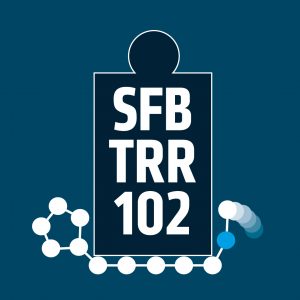 by Martin Luther University Halle-Wittenberg and Leipzig University, will start into its third funding period in July 2019. The German Research Foundation (DFG) is funding the project for another four years with about nine million euros.
by Martin Luther University Halle-Wittenberg and Leipzig University, will start into its third funding period in July 2019. The German Research Foundation (DFG) is funding the project for another four years with about nine million euros.
The research in the CRC TRR 102 deals with the properties and structure formation processes of synthetic polymers and biopolymers. In the latter area, especially the aggregation processes of peptides to amyloid structures are of large interest. In the third funding period, based on the findings to date in both areas, hybrid polymers, in which synthetic and biological parts act as design elements in the other part, will now be given more prominence and their structure formation will be investigated. The findings could be relevant to both materials research as well as to the study of diseases such as Alzheimer’s with which amyloids are associated.
The CRC TRR 102 is carried out by Martin Luther University Halle-Wittenberg as speaker university together with Leipzig University. From Leipzig University, physicists from the Peter Debye Institute for Soft Matter Physics, the Institute for Theoretical Physics and the Institute for Medical Physics and Biophysics are participating. Further participating institutions are the Leibniz Institute for Surface Engineering in Leipzig, the Fraunhofer Institute for Microstructure of Materials and Systems IMWS in Halle and the Max Planck Institute for Colloids and Interfaces in Potsdam/Golm.
First Prize for Talk at Annual BuildMoNa Conference
On March 18 and 19, 2019, the annual conference of the Leipzig School of Natural Sciences – Building with Molecules and Nano-objects (BuildMoNa) took place. In addition to lectures by renowned guest speakers, the program also included contributions from doctoral candidates in the form of talks and posters. The three best talks of the doctoral candidates were awarded with prizes. Martin Fränzl from the Molecular Nanophotonics Group at the Peter Debye Institute for Soft Matter Physics obtained the first prize for his talk on a thermophoretic trap for the investigation of individual amyloid fibrils, which are associated with numerous neurodegenerative diseases.
How Maxwell’s Demon Herds Sheep: Information-based Interaction of Artificial Microswimmers
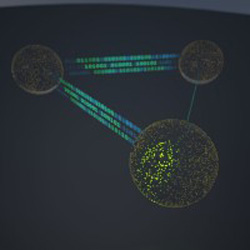 Scientists from the universities in Leipzig and Princeton have found out in experiments how new structures with special properties can emerge through the exchange of information between individual objects. They managed to connect objects – so-called artificial microswimmers – with specific information. These polymer spheres decorated with tiniest gold nanoparticles can move directionally in liquids. The physicists and chemists found out in their experiment that these microswimmers, which, like living systems, convert energy into an active motion, can be bound together by this motion. They have now published this insight in the journal “Nature Communications”.
Scientists from the universities in Leipzig and Princeton have found out in experiments how new structures with special properties can emerge through the exchange of information between individual objects. They managed to connect objects – so-called artificial microswimmers – with specific information. These polymer spheres decorated with tiniest gold nanoparticles can move directionally in liquids. The physicists and chemists found out in their experiment that these microswimmers, which, like living systems, convert energy into an active motion, can be bound together by this motion. They have now published this insight in the journal “Nature Communications”.
Physics investigates interactions that hold the elementary building blocks of matter together and create materials with all their properties as we naturally use them today. Besides these fundamental forces, there are also mechanisms that form structures without the need for a direct force between the objects. Such self-organization processes exist, e.g., in swarms of bees or birds. Living organisms absorb information from their environment, process and respond to it. Already cells or bacteria register information from their environment via receptors and control their movement accordingly. Information and its processing is therefore an important ingredient of living systems.
“However, artificial systems such as the microswimmers examined by the researchers can not process this information and react to it,” says Utsab Khadka, a postdoctoral fellow in Haw Yang’s research group at Princeton University in the USA. To make these microswimmers a little smarter, the researchers use a laser that, based on the information about the distance of other swimmers, decides in which direction the swimmers shall move. “Once one detects, processes, and responds to information from the environment, one has the opportunity to go beyond the effects of physical forces,” explains Frank Cichos, Professor for Molecular Nanophotonics in Leipzig. “It is possible to create structures that are no longer simply a result of the complex interplay of charge interactions,” he adds.
In physics, there is a famous thought experiment devised by James Clerk Maxwell – Maxwell’s demon: A little demon is able to open and close a massless door between two rooms without doing work. He observes the gas molecules in the two rooms and, based on his observation, he lets the fast molecules through the door into one of the two rooms and leaves the slow ones in the other room. This creates a temperature difference between the two rooms without the demon having to do any work. At first glance, the process violates the laws of physics, because it allows exploiting the arising temperature difference to propel a heat engine which would produce work from nothing. “To solve the apparent problem, the information that the demon collects about the gas molecules must be incorporated into the physical description,” says Viktor Holubec, a theoretical physicist whose current work at Leipzig University is supported by a Humboldt Scholarship.
The researchers from Leipzig and Princeton use in their experiments the information about the distance to other microswimmers. The polymer spheres react to this distance and thereby organize themselves into a kind of microswimmer molecule. These structures exist only as long as the swimmers are actively moving and have internal dynamics similar to real molecules. From these model studies, Khadka, Holubec, Yang and Cichos hope to see what role information plays in the collective behavior of living organisms. The control strategies developed by the researchers can also be combined with machine learning algorithms to use intelligent swarms of artificial microswimmers beneficially in the future, for example for the treatment of diseases or in the purification of waters.
Reference: U. Khadka, V. Holubec , H. Yang, F. Cichos: Active Particles Bound by Information Flows, Nat. Commun. 9, 3864 (2018)
Source: Translated from the Press Release of Leipzig University
Pupils Competition experiNat 2018
For the twelfth time, the Leipziger invited all pupils of the 9th and 10th classes in and around Leipzig to demonstrate their scientific knowledge and skills. Currently, until March 27, 2018, the pupils competition experiNat 2018 takes place, in which the pupils have the opportunity to change the classroom against a modern research laboratory and a real training workshop on two days. Aim of the experiNat is to increase the interest of the pupils in the natural sciences. Also this year, the Faculty of Physics and Earth Sciences of Leipzig University is supporting the experiNat with an experimental lecture to give an insight into the fascination of physics. The lecture was given on March 6, 2018 by Prof. Dr. Frank Cichos on the topic “I kreuz B – Nichts für Linkshänder” with the assistance of Axel Märcker.
Light-driven Micromachines: Microparticles Stir Liquids
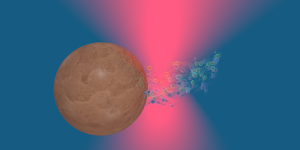
Scientists from Leipzig University have developed together with international researchers a tiny machine powered by a focused laser beam. The machine can serve as the basis for the construction of microscopic drives.
With machines one associates the idea of motors, axles or gear wheels. Such systems play an important role for the technological progress since the development of the steam engine. Again and again they inspire the urge to realize machines as drives even on the smallest length scale, that is on a few micrometers. Such versatile are also the developments which range from mechanical elements to small steam engines. In liquids, on the other hand, other physical processes are of importance: on a few micrometers, the strong friction in the liquid and the trembling caused by Brownian motion determine the dynamics of smallest objects.
A team of scientists from the University of Gothenburg in Sweden, the Bilkent University in Turkey and Leipzig University now describes in the renowned journal Physical Review Letters how a tiny light-driven machine is created with the help of light and a particle of only a few micrometers in size. This machine stirs a special liquid mixture in the truest sense of the word and could thus in the future serve for mixing small amounts of liquid in which this is otherwise only hardly possible due to the dimensions.
Falko Schmidt, former physics student at Leipzig University and now doctoral candidate in the working group of Prof. Dr. Giovanni Volpe at the University of Gothenburg in Sweden, has studied these machines and explaines: “Our micromachine is not so much different from a steam engine. The energy for the drive is provided by a focused laser beam that heats the particle and its surroundings. At the same time, the laser also works as optical tweezers and keeps the particle in a stable position in the liquid.” Ultimately, the decisive factor in this machine is a special mixture of two liquids: lutidine and water. Above a temperature of about 34 degrees Celsius, these two liquids demix. Exactly this temperature is achieved by the optical heating of a microparticle covered with iron oxide. Small differences in the density of the iron oxide particles in the microparticle help to bring the mixture on one side earlier to demix.
“This demixing drives our machine and lets the particle rotate at up to 1160 rotations per minute in the optical tweezers”, says Falko Schmidt. The team of scientists emphasizes that such machines could be used for chemical analysis applications on the smallest length scales. “They can help to mix smallest amounts of liquid or to drive more complex machines”, says Prof. Volpe, who leads the project. “The work also shows how dissipation, that is the release of energy in the form of heat, can also be used at the microscale for the active motion of particles and to perform work”, explains co-author Prof. Dr. Frank Cichos from the Peter Debye Institute for Soft Matter Physics at Leipzig University. Dissipation is one of the exciting topics that will be of growing importance in the next few years, especially in physics at Leipzig University.
Reference: F. Schmidt, A. Magazzù, A. Callegari, L. Biancofiore, F. Cichos, G. Volpe: A Tiny Engine Powered by Light and Liquid Physics, Phys. Rev. Lett. 120, 068004 (2018)
Source: Translated from the Press Release of Leipzig University
Pupils Levitate Water by Means of Acoustic Waves in an Internship
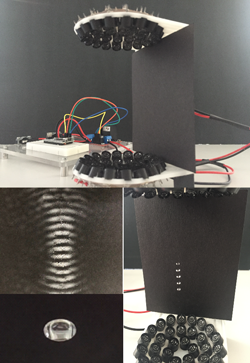 Optical tweezers have become an important tool in the study of soft condensed matter. They can be used to trap colloidal particles and to measure tiniest forces.
Optical tweezers have become an important tool in the study of soft condensed matter. They can be used to trap colloidal particles and to measure tiniest forces.
Paul-Finian Demmer, a pupil from the Dietrich-Bonhoeffer-Gymnasium in Wiehl, and Anton Brandt, a pupil from the Gymnasium Neue Nikolaischule Leipzig, have built up the equivalent of an optical tweezers – an acoustic tweezers – in the Molecular Nanophotonics group. In contrast to optical tweezers, the acoustic levitator is based on standing acoustic waves generated by an array of ultrasound sources. The two pupils have built 72 of these ultrasound sources into a structure of a 3D printer. The standing acoustic wave is able to levitate small drops of a few microliters in volume and other objects against gravity. With the aid of microscopic particles, Paul-Finian and Anton succeeded in taking an image of the pressure distribution of the ultrasonic wave. In their further experiments they now want to study the vaporization of levitating water drops.
Thermally Trapped Single Molecules
Here it is finally. The paper by Marco on trapping single DNA molecules just got accepted by Nano Letters. Congratulations Marco! Yet another occasion for a great cake for the lab!
Photothermal Light Modulator
This has been a true fight. After some strange and even contradicting referee reports in Nano Letters we are now happy to have the “photothermal light modulator” published in ACS Nano. Congratulations André for the first paper.
Thermophoretic Single Particle Trap
Following a long preparation time of the manuscript, Marco finally succeeded to get his paper on single particle thermophoretic trapping accepted by ACS Nano. Congratulations!
Thermally Driven Nanobots …
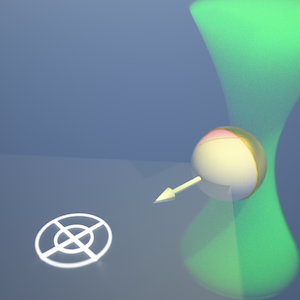 How control microbots using thermal fluctuations? This is answered jointly with our colleagues from Princeton University (Prof. Haw Yang, Chemistry Department) in our recent paper on “Harnessing thermal fluctuations for purposeful activities: the manipulation of single micro-swimmers by adaptive photon nudging”, which appeared yesterday in Chemical Science online.
How control microbots using thermal fluctuations? This is answered jointly with our colleagues from Princeton University (Prof. Haw Yang, Chemistry Department) in our recent paper on “Harnessing thermal fluctuations for purposeful activities: the manipulation of single micro-swimmers by adaptive photon nudging”, which appeared yesterday in Chemical Science online.
And The Winner Is …
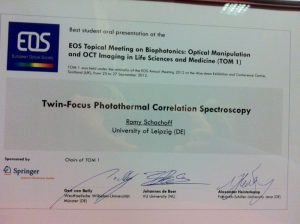 This time, the winner is Romy, collecting a prize for the best student oral presentation at the European Optical Society topical meeting on Biophotonics: Optical Manipulation and OCT Imaging in Life Sciences and Medicine. Congratulations!
This time, the winner is Romy, collecting a prize for the best student oral presentation at the European Optical Society topical meeting on Biophotonics: Optical Manipulation and OCT Imaging in Life Sciences and Medicine. Congratulations!
And The Winner Is …
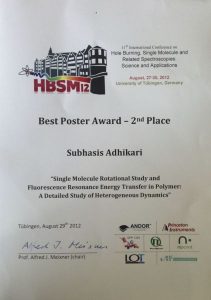 This time, the winner is Subhasis, collecting a prize for the 2nd best poster at the 11th Hole Burning, Single Molecule and Related Spectroscopies Meeting in Tübingen. Congratulations!
This time, the winner is Subhasis, collecting a prize for the 2nd best poster at the 11th Hole Burning, Single Molecule and Related Spectroscopies Meeting in Tübingen. Congratulations!
Next Paper Arrived
 After a long battle our paper on “Gaussian beam photothermal single particle microscopy” has finally found its way into the JOSA. Photothermal single molecule detection is thus getting easy.
After a long battle our paper on “Gaussian beam photothermal single particle microscopy” has finally found its way into the JOSA. Photothermal single molecule detection is thus getting easy.
And The Winner Is …
Well, we did not win the fight against the other 9 short films during the 1. Nano-Kurzfilm Filmfestival in Halle yesterday, but at least we realized that our contribution matches the overall outstanding quality of the other movies.
Objekte auf Nanometerskala werfen keinen Schatten bei Beleuchtung mehr. Das Licht wird an ihnen gestreut, je kleiner die Partikel, desto weniger, bis die Partikel nahezu vollkommen unsichtbar sind. Solche Nanopartikel sind kaum in der Mikroskopie zu erkennen und erfordern neue optische Methoden. Die photothermische Mikroskopie nutzt dazu die Absorption von Licht durch die Nanopartikel. Das absorbierte Licht wird in Wärme umgewandelt und verändert die Temperatur und damit die optischen Eigenschaften in seiner Umgebung. Dadurch erscheint das Nanoobjekt größer und wird detektierbar. Der eigentliche Effekt ist allerdings noch diffizieler, da auf der Längenskala von wenigen Nanometern die Wellennatur des Lichtes hervortritt. Licht wird gebeugt und erzeugt komplexe Interferenzstrukturen. Markus Selmke und Marco Braun haben herausgefunden, dass der spezielle räumliche Verlauf der optischen Brechkraft um das Nanopartikel Effekte erzeugt die einer makroskopischen Zerstreuungslinse entsprechen, obwohl man sich auf der Nanometerskala befindet.
10 Left
After some great performance of our two movie actors Marco and Markus, the hard work pays off. The nanspot is among the 10 last spots in the 1.Nano-Kurzfilm-Festival.
The three winners will be selected from this last round of 10 spots on the 5th of July in Halle. So stay tuned!
Nanospots
 Yesterday was devoted to our two TV stars Marco and Markus, who have performed for a short spot on Nanoscience. Wait for the outtakes …
Yesterday was devoted to our two TV stars Marco and Markus, who have performed for a short spot on Nanoscience. Wait for the outtakes …
Two Poster Prizes
Two PhD students of the group have been awarded with a poster prize at the annular spring meeting of the DPG.
The winners are Romy Schachoff and Andreas Bregulla. Congratulations!
The two posters are entitled
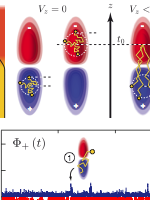 “Twin-Focus Photothermal Correlation Spectroscopy – Twin-PhoCS”
“Twin-Focus Photothermal Correlation Spectroscopy – Twin-PhoCS”by Romy Schachoff, Markus Selmke, Marco Braun and Frank Cichos
 “Rotational Behavior of Thermophoretically Driven Janus Particles at a Hard Wall”
“Rotational Behavior of Thermophoretically Driven Janus Particles at a Hard Wall”Andreas Bregulla, Ralf Seidel, Michael Mertig, Klaus Kroy and Frank Cichos
New Papers
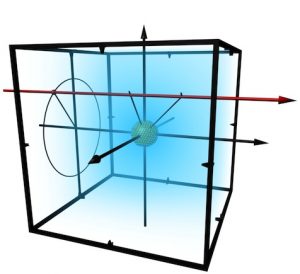 The group has published two new papers on photothermal single particle detection in ACSNano and Optics Express. The ACSNano paper has been well acknowledged in a number of press reports. Congratulations to the authors Markus Selmke and Marco Braun.
The group has published two new papers on photothermal single particle detection in ACSNano and Optics Express. The ACSNano paper has been well acknowledged in a number of press reports. Congratulations to the authors Markus Selmke and Marco Braun.

